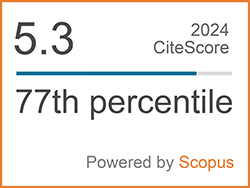Effects of Surface Finishes on Corrosion Resistance of Welded Stainless Steels
Abstract
Corrosion resistance of welded stainless steels with different surface finishes was studied. The materials used in this study were the welded UNS S 30400/S 30400, S 30400/ S 31803 and S 31803/ S 31803. The welded pieces were mechanically ground then they were subjected to the different surface finishing processes which were as-received (S1), passivation (S2), fine grinding followed by passivation (S3) and grinding followed by electropolishing (S4). Corrosion resistance behavior of the welded specimens as well as the base metals were determined by poteniodynamic technique (PD) and the sensitization due to heat during welding was determined by electrochemical poteniokinetic reactivation technique (EPR).
It was found that for S 30400 and S 30400/30400, pitting potentials (Epit) of S2, S3 and S4 were 3 times, 2 times and 3 ½ times respectively higher than those of S1. For S 30400/S 31803, Epit of S2 and S4 were almost twice of the as-received one but Epit of S3 was only 85 mV greater than that of S1. The surface finishes could increase corrosion resistance of S30400 and welded S 30400 significantly. For S 31803 and the S 31803/S 31803, S2 had the highest pitting potential and was 1 ½ time greater than that of S1. Sensitization was determined by the charges released from the welded specimens. The charges released values of S 30400/S 30400, S30400/S 31803 and S 31803/S 31803 are 176, 43 and 0.1 milli Coulomb/cm2 respectively
Keywords
Refbacks
- There are currently no refbacks.
 Applied Science and Engineering Progress
Applied Science and Engineering Progress







